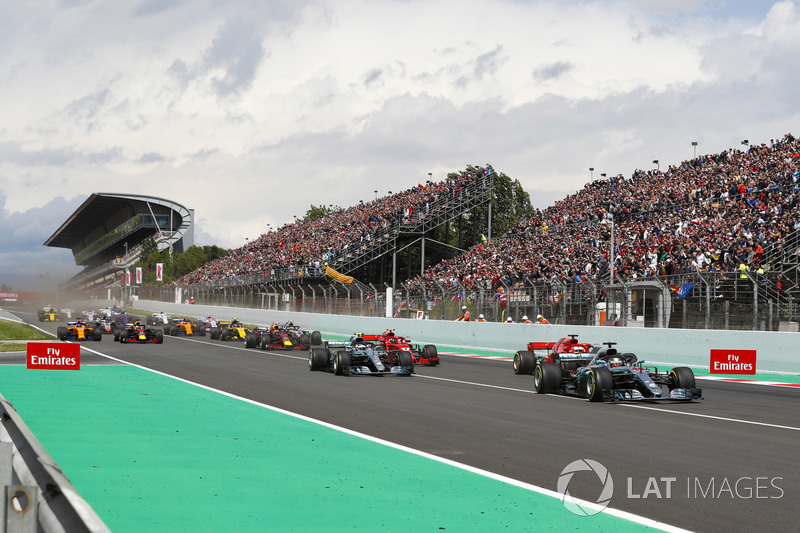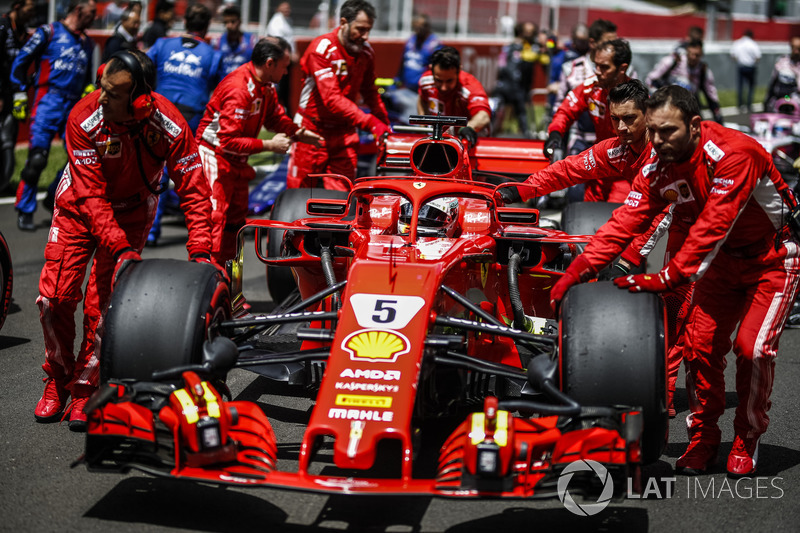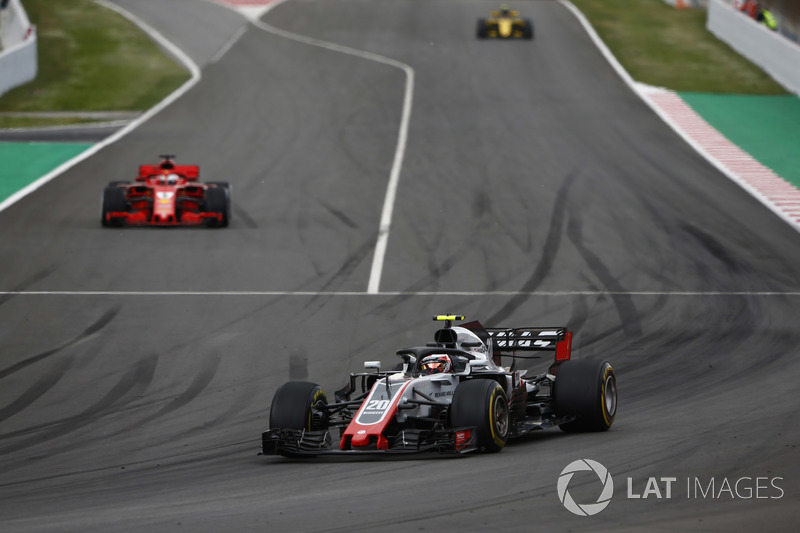Strategy Report: Was Spanish GP the start of a trend?
James Allen analyses the Spanish Grand Prix, and asks if the dominant performance of Mercedes is a sign of things to come.

James Allen

Motorsport Blog
Motorsport Blog
We said at the start of this 2018 F1 season that with the car that it has, Ferrari could win the championship only if it executes perfectly.
Some strategy calls have gone well, others like Bahrain they have got away with because of the driver, others have gone wrong and so has the driver, like Baku.
But in Spain Ferrari was on the defensive: on race pace, strategy, tyre usage and engine reliability, they were fighting a rearguard action and Mercedes enjoyed the most dominant winning margin of the season.
Was this the start of a trend, after a shaky Mercedes start to the season, or an outlier of a race due to Pirelli changing the tyres for this race (and two later ones in France and UK)?
Pre-race considerations
It is never desirable to change something fundamental, like tyres, during a racing season. For one thing it always gives rise to conspiracy theories that the change was motivated by the team who subsequently wins the race to the detriment of the team that loses.
F1 fans have fresh memories of Mercedes struggling to master the tyres in 2013 until they did a controversial test, and from that point onwards started winning races.
The idea of Pirelli bringing a tyre with thinner gauge arose after teams experienced blistering at the winter tests in February and early March. All the leading teams were part of that request to Pirelli. Knowing that they had time from a logistical point of view, the company obliged with tyres for Spain, France and Silverstone, where the problem was mostly expected to arise.
Up to that point in 2018, the supersoft had been a tyre that Ferrari had worked better than Mercedes in the opening rounds of the championship. But now it wasn’t to anyone’s liking, and we had the highly unusual spectacle in the Q2 session, which decides the starting race tyre, of all but one car going for it on the soft compound instead.
Only Fernando Alonso set his fastest time in Q2 on supersofts, and therefore started the race on it. When only one car in the whole field, as it subsequently turned out, starts on the ‘qualifying’ tyre, then something is wrong.
Interestingly, Sauber was the only team to ignore the supersoft completely in Friday practice and focused on optimising a soft-medium strategy. It worked for Charles Leclerc, who got another solid points finish in after a battle with Alonso.
Leclerc was ahead and knew Alonso couldn’t overcut as he couldn’t extend on his supersoft tyres. Sauber also knew it could never pit Leclerc before the safe moment for a one stop, to be able to reach the end on mediums.
For the midfield, the battle centred on doing a better job of calculating how early your car could get to the end on medium tyres.

Doing the opposite
‘Track position is king’ goes the saying, and at some tracks you give it up only if you absolutely have to. On fast open tracks with good overtaking possibilities, it’s all about doing your fastest race, not worrying too much about being held up by slower cars after a pit stop.
In Spain it’s different, especially with the 2018 generation cars. It’s very hard to overtake. Even a big tyre offset doesn’t compensate; track position was indeed king. This was demonstrated vividly after Hamilton’s pitstop, where on fresh tyres he couldn’t get past Verstappen, whose tyres had done over 30 laps.
And so when Ferrari – fearing an undercut attempt by Valtteri Bottas – pulled Sebastian Vettel in to the pits on Lap 17 from a second place he had gained from Bottas at the start, committing him to a two stop race, it did several things at once.
First, it brought him out behind Kevin Magnussen, as he didn’t have enough of a gap back to clear the Dane. He lost some vital time there.
Second, it determined Lewis Hamilton’s strategy for the afternoon as the Englishman was running in clear air, which causes less damage to the tyres, and he was able to extend his first stint to the point where he could move directly onto mediums to the finish of the race.
It also determined Bottas’s strategy, as Mercedes pushed Bottas to do two more hard laps while Vettel was losing time behind Magnussen, the target being to then overcut him at the stop. A problem with one of the rear wheels meant that Bottas’s stop was 3.9s, almost twice the normal length and he rejoined behind Vettel.
That was two setbacks in the first part of the race for Bottas, who’d lost the start to Vettel – after his blowout in Baku, he must be wondering when his luck will change.
It told everyone that Vettel was on a two stop, and Bottas almost certainly as well as they had almost 50 laps to go to the finish. Both teams went into the race with two stops in mind.
Ferrari were getting through the tyres more voraciously than Mercedes and far more so than Red Bull, who had seen in Friday practice that they could hold on to them longer that their rivals and that opened up the possibility of a one stop race, from soft to medium.
But Ferrari had another problem that was undermining its performance; the engine. As at the end of last season, when Vettel’s title hopes went away with reliability concerns on the engine, so in Spain: Raikkonen lost an engine in practice and then another problem in the race caused alarm bells.
One of the problems has been traced to an electrical fault, and that engine may be used again for practice later in the season. But Vettel’s race was doubly compromised by instructions to take care of the engine after Raikkonen retired before half distance.
Added to Ferrari’s strategy move to bring Vettel in on Lap 17 for the first stop, to prevent Bottas from undercutting him, it added up to a defensive race for Ferrari, rather than an offensive one.
This is the real story of Ferrari’s strategy in Spain, not the focus on the second stop under the Virtual Safety Car. That dropped Vettel down to fourth place where he eventually finished.
By that point he was already well and truly on the defensive, and the move under the VSC was the right thing to do as it meant that the stop cost half as much time relative to the field as stopping at racing speeds.
Ferrari had been hoping for a VSC or a Safety Car, knowing Vettel had to stop again. Every race this season has had one; it’s becoming a clear pattern.
Vettel dropped to fourth and stayed there because his positioning was slightly out on the pit box entry, and also he was held momentarily for another car passing so as not to be released unsafely.
This allowed the one-stopping Verstappen to get past him for a podium finish. Mercedes, meanwhile, ‘did the opposite’ when Vettel stopped. Ferrari had been relying on the Finn also needing to stop a second time after an early first stop, but when Vettel pitted the instruction was to stay out and try to make the finish.
There was only a very small probability that the VSC for Ocon’s broken down car could become a Safety Car, which might have made the decision to stop more pressing. The strategists on the pit wall are racing mathematicians, who calculate probability and risk/reward in real time throughout the race.
Bottas was able to make the tyres last to the finish for a one-two for Mercedes. He was helped by Verstappen breaking off part of his front wing in a collision. Although he maintained remarkably strong lap times, it inevitably imbalanced the car and despite having tyres that were 15 laps fresher, he could not get close to Bottas.
The UBS Race Strategy Report is written by James Allen with input and data from several F1 team strategists and from Pirelli.
Race History Chart
Kindly provided by Williams Martini Racing, click to enlarge
The number of laps is on the horizontal axis; the gap behind the leader is on the vertical axis. The thing to look at is the gaps between the cars and also the relative pace of the cars. A positive sign is an upward curve indicating strong pace as lap time falls.
On the race history chart, it is immediately apparent that Hamilton won the race in the opening stint as he had pace that Vettel could not live with. The Ferrari is managing rather than dropping off in tyre performance at the end of the first stint, but the trend is certainly downwards before the VSC intervenes for the second stop.
Relative to Hamilton and Verstappen, who continue to rise, it’s clear that Ferrari didn’t have the race pace in Spain for various reasons. Haas was clearly the fourth fastest car in Spain – look at Magnussen’s lonely race, but also at how well clear of the Renault of Sainz he is.
Tyre Usage Chart
A collectors’ item: The highly unusual sight on the tyre usage chart of only one car, Alonso, starting on the ‘qualifying’ tyre!
Be part of Motorsport community
Join the conversationShare Or Save This Story
Subscribe and access Motorsport.com with your ad-blocker.
From Formula 1 to MotoGP we report straight from the paddock because we love our sport, just like you. In order to keep delivering our expert journalism, our website uses advertising. Still, we want to give you the opportunity to enjoy an ad-free and tracker-free website and to continue using your adblocker.



























Top Comments